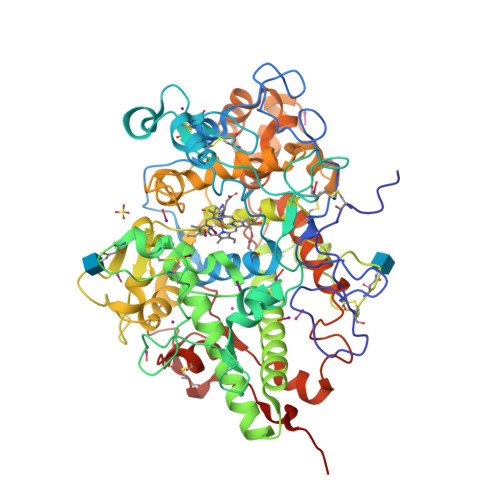Structural evidence of the oxidation of iodide ion into hyper-reactive hypoiodite ion by mammalian heme lactoperoxidase.
Singh, P.K., Ahmad, N., Yamini, S., Singh, R.P., Singh, A.K., Sharma, P., Smith, M.L., Sharma, S., Singh, T.P.(2022) Protein Sci 31: 384-395
- PubMed: 34761444
- DOI: https://doi.org/10.1002/pro.4230
- Primary Citation of Related Structures:
7VE3 - PubMed Abstract:
Lactoperoxidase (1.11.1.7, LPO) is a mammalian heme peroxidase found in the extracellular fluids of mammals including plasma, saliva, airway epithelial lining fluids, nasal lining fluid, milk, tears, gastric juices, and intestinal mucosa. To perform its innate immune action against invading microbes, LPO utilizes hydrogen peroxide (H 2 O 2 ) to convert thiocyanate (SCN - ) and iodide (I - ) ions into the oxidizing compounds hypothiocyanite (OSCN - ) and hypoiodite (IO - ). Previously determined structures of the complexes of LPO with SCN - , OSCN - , and I - show that SCN - and I - occupy appropriate positions in the distal heme cavity as substrates while OSCN - binds in the distal heme cavity as a product inhibitor. We report here the structure of the complex of LPO with IO - as the first structural evidence of the conversion of iodide into hypoiodite by LPO. To obtain this complex, a solution of LPO was first incubated with H 2 O 2 , then mixed with ammonium iodide solution and the complex crystallized by the addition of PEG-3350, 20% (wt/vol). These crystals were used for X-ray intensity data collection and structure analysis. The structure determination revealed the presence of four hypoiodite ions in the substrate binding channel of LPO. In addition to these, six other hypoiodite ions were observed at different exterior sites. We surmise that the presence of hypoiodite ions in the distal heme cavity blocks the substrate binding site and inhibits catalysis. This was confirmed by activity experiments with the colorimetric substrate, ABTS (2,2'-azino-bis(3-ethylbenzthiazoline-sulfonic acid)), in the presence of hypoiodite and iodide ions.
Organizational Affiliation:
Department of Biophysics, All India Institute of Medical Sciences, New Delhi, India.
























